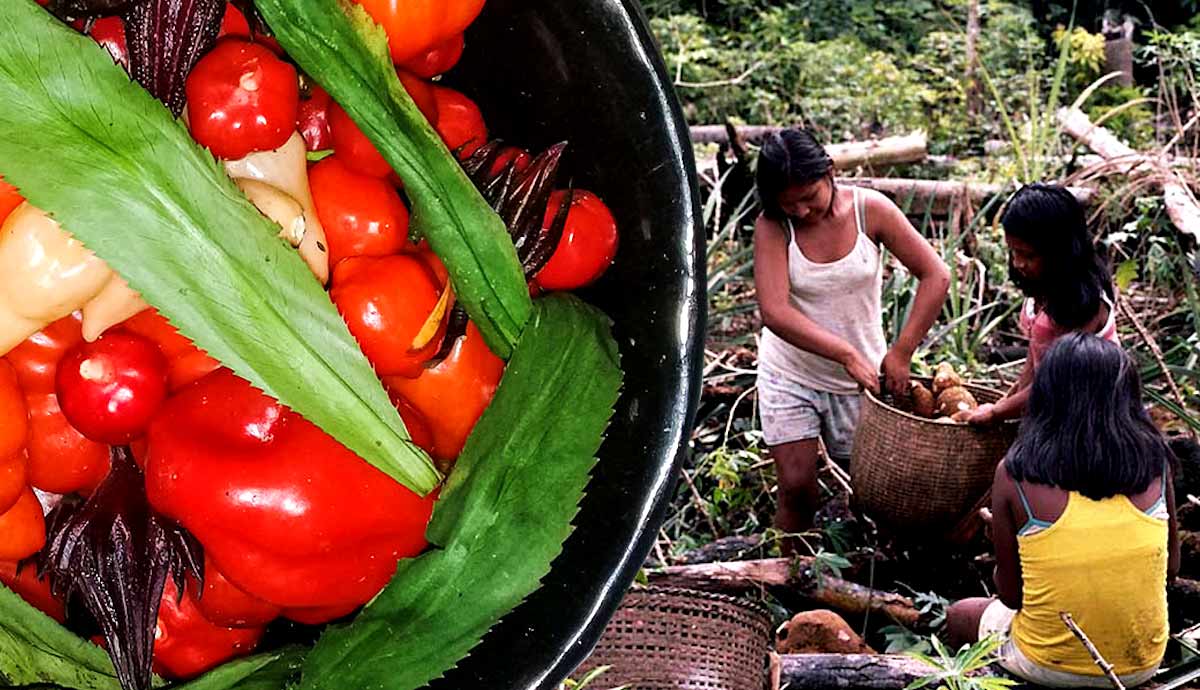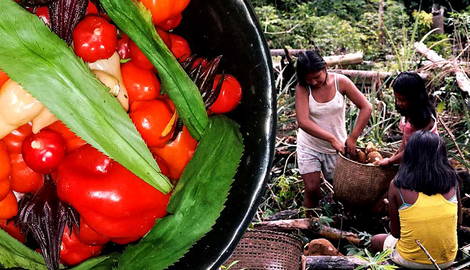
Indigenous communities living in the Amazon rainforest are well-known for producing their food through ecological cultivation strategies in defined portions of terrain called chagras. The soil is used to grow foods, including up to 100 different vegetal species, that can coexist in biological balance without altering each other’s natural life cycles. Chagras reflect a profound understanding of the relationship between humans and their environment, embodied in agricultural practices and reproduced through traditional knowledge about the interactions between plants, animals, minerals, and the spiritual ancestors shared by all community members.
Traditional Knowledge and the Chagra

Chagras are located next to malocas, traditional houses where daily life and ritual activities occur and where different families from the same community interact. Although the term chagra is used for the defined parcels of territory cultivated to provide food for the community, in a broader sense, the chagra agricultural model is a complete alimentary system based on traditional ecological, social, and spiritual knowledge of the biological relationships between vegetal species, relationships with the soil, production cycles, diseases, and plagues.
This system has survived for several centuries and has developed in conjunction with the biological and cultural evolutionary processes of the Amazon rainforest, which have allowed for the domestication of numerous species and the preservation of a broad genetic base for many plants and animals.

Indigenous communities in the Amazon rainforest have preserved sophisticated knowledge of these relationships. The chagra presents balanced, reciprocal, and sustainable strategies to preserve the cohabitation of humans and vegetal and animal species in a shared environment. These practices have been passed from generation to generation through oral history and practice-based learning, which include the retelling of mythical stories and bio-spiritual explanations that all community members must learn from childhood.
Although the chagra model refers principally to the cultivation of food, some of the related practices linked to this alimentary system include hunting, gathering fruits and vegetables, and fishing. These practices have specific gender and age divisions and work in conjunction to ensure the well-being of the community and all organisms inhabiting the rainforest.
The Chagra Production Cycle

The chagra’s production cycle has been designed over centuries to avoid disturbing the natural balance of the ecosystem. The first step to setting up a chagra is selecting an adequate portion of land, which depends on the location, soil type, and surrounding vegetation. Before selecting the parcel, communities often need to negotiate with the land’s spiritual owners to allow human intervention, a task the local shaman or women often carry out. In a special ceremony, tobacco smoke is spread over the field to protect the cultivation process and establish shamanic relationships with the world of guiding spirits that guard the forest.
After the spiritual and spatial preparation of the terrain is completed, all the vegetation is cut during the dry season between December and February. This happens in two stages: the socola, where small vegetation is removed, and the tumba, where the bigger trunks are cut in collective efforts that can gather men from neighboring communities.
Any organic material remaining is burned to release nitrogen, with the resulting ash fertilizing the soil. The terrain is allowed to cool for a period of two weeks, after which the women of the community take over the protection and correct functioning of the chagra.

When the rainy season comes, between March and July, the levels of the rivers rise, and the sowing period begins. Women know the seeds’ different properties and each plant’s growing processes. Some of the main products grown and collected in the chagra include yuca (cassava), corn, banana, pineapple, coca, tobacco, and peanuts.
Some areas of the chagra are reserved for peppers and sacred herbs and plants. As different species start to grow, the women eliminate competitor weeds, burning them to transform them into nutrient-rich ashes, which are then used to fertilize the other plants. No species is considered a threat or waste, as most of them can be repurposed to benefit the chagra in some way.
After the chagra completes its productive cycle, the shaman conducts a closing ritual, and the terrain is abandoned to allow it to recover. The community then moves forward with finding a new parcel of land to start the productive cycle of a new chagra over again. The parcel left behind is often used for hunting, as many rodents come to feed on the remaining cassava.
The Cultural Importance of the Chagra: The Principle of Complementarity

Chagras are biological and social spaces for preserving traditional cultural knowledge. They are also an example of how communities exercise their right to food sovereignty in Latin American countries that often give more priority to the capitalist models that exploit the valuable natural resources located in ancestral territories.
Together with the malocas, chagras are sites where ancestral knowledge is taught to younger generations, instructing them in how to cultivate and collect food and reinforcing a strong sense of community and cultural identity. In addition to sharing this specialized knowledge, they are places for acquiring and learning social values related to ethics, health, nutrition, and rituals, which makes the whole process surrounding the chagra one of the cornerstones of social formation in these indigenous communities.
One of the main cultural principles of livelihood and well-being among these communities is complementarity and interdependence. This refers to the reciprocal relationships between men and women, as well as the physical and spiritual worlds. These relationships ensure the correct balance in life through collaboration and collective work. For instance, in the chagra, the principle of complementarity is reflected in how poisonous, itchy, edible, and sacred plants can coexist without any problem.
The principle of complementarity is the basis on which the cultural significance and biological functioning of the chagra are constructed. Through the tumba, burning, and cultivation of the terrain, the landscape is constantly revitalized by selecting and facilitating the growth of palms and trees that produce food for fish, animals, and humans.
A Bio-Spiritual Model for Protecting the Amazon Rainforest

Contemporary exploitative capitalist models of agriculture could learn much from the chagra. They demonstrate ecological ways different species can co-exist and grow in a single defined space. Their logic opposes intensive agricultural systems based on fast rates for producing single species in single terrains, an economic dynamic that harms the soil and serves individual and institutional interests, often excluding the communities that own the ancestral territories. The model of the chagra is a result of broader socio-cultural structures of reciprocity between indigenous communities and the environment.
Historically, the cultural and biological integrity of the Amazon rainforest has been threatened by colonial and capitalist exploitation. Since the 1970s, the chagras have been becoming less and less diverse and extensive due to indigenous slavery and the exploitation of natural resources such as quinoa and rubber. Additionally, and more contemporarily, intensive palm oil and soy farming and extensive livestock farming produce increasing levels of deforestation that, day by day, are destroying the biological and social fabric of the rainforest.
Although this has forced many communities to abandon their territories, putting them in a situation of displacement, others are organizing themselves into political and activist groups, simultaneously fighting for their right to their territory and protecting the Amazon rainforest. These efforts include the preservation of the chagra as a holistic bio-spiritual model for coexisting with the environment, assuring a correct and balanced use of natural resources through relationships of reciprocity.

Chagras are sources of knowledge and wisdom that could be used to solve the many problems generated by the world’s industrialization, where natural resources are becoming less and less available and where the effects of capitalist exploitation of the environment are altering the ecological balance of nature around the globe. The model of the chagra speaks to ecological harmony and considers biodiversity conservation and sustainable agriculture crucial knowledge for mitigating the effects of global warming and the unequal distribution of rights to the land in different countries.
Chagras are currently in danger of extinction, as many multinational corporations are expanding their power over their lands, causing immense damage to the forest. This results from illegal occupation of the land as well as through violent interactions with the communities. Nonetheless, many NGOs and organized indigenous communities remain, fighting for the protection of their environment and land justice in the Amazon rainforest.







